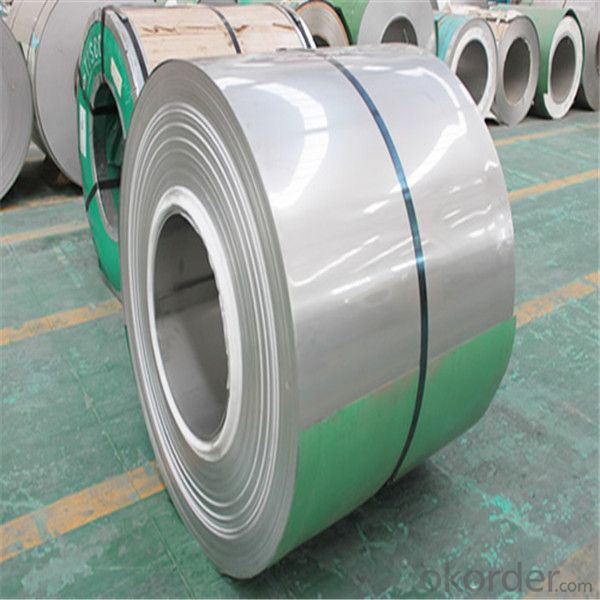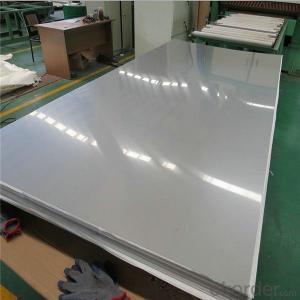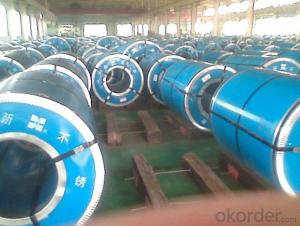Stainless Steel Coil and Sheet with Best Quality
- Loading Port:
- Shanghai
- Payment Terms:
- TT OR LC
- Min Order Qty:
- 3 m.t.
- Supply Capability:
- 100000 m.t./month
OKorder Service Pledge
OKorder Financial Service
You Might Also Like
Item specifice
Product Details
stainless steel sheet
Width:500-2000mm( Common width:1000mm,1219mm,1250mm,1500mm, 2000mm)
Length:1000-6000mm or as your request
Surface:No1,No4, 2B, BA, 8K, etc.
Standard:ASTM, AISI, JIS, GB, DIN,EN, etc
Materia:201,202,304,304L,304J1, 316,316L,321,309S,310S,409L, 430
Technique:Cold Rolled or Hot Rolled
Certification: ISO,SGS
Package:Waterproof paper, steel strip packed, wooden case or pack as customers requirement.
Application:Used in construction, chemical industry, electricity industry, food service industry, paper-making industry,and so on.
Payment&Shipping terms
Price | FOB USD1800-2500 per ton |
Min Qty | 5 ton we can also accept as a trail order for our first cooperation |
Port | Shanghai China or any port of China |
Packing | Waterproof paper, steel strip packed, wooden case or pack as customers requirement.
|
Delivery time | 7-10 days after the confirmation of the deposit. |
Trade terms | FOB/CFR/CIF |
Payment terms | TT/LC 30% Prepayment by T/T in advance , 70% with the copy of B/L within 3working days by T/T 30% Prepayment by T/T in advance, 70% by L/C at sight
|
Chemical composition:
TYPE NO. | C | Mn | P | S | Si | Cr | Ni | Mo |
201 | ≤0.15 | 5.5-7.5 | ≤0.050 | ≤0.030 | ≤1.00 | 16.0-18.0 | 3.5-5.5 | |
202 | ≤0.15 | 7.5-10 | ≤0.060 | ≤0.030 | ≤1.00 | 17.0-19.0 | 4.0-6.0 | |
301 | ≤0.15 | ≤2.00 | ≤0.045 | ≤0.030 | ≤1.00 | 16.5-18.0 | 6.0-8.0 | |
302 | ≤0.15 | ≤2.00 | ≤0.045 | ≤0.030 | ≤1.00 | 17.0-19.0 | 8.0-10.0 | |
304 | ≤0.08 | ≤2.00 | ≤0.045 | ≤0.030 | ≤1.00 | 18.0-20.0 | 8.0-10.5 | |
304L | ≤0.03 | ≤2.00 | ≤0.045 | ≤0.030 | ≤1.00 | 18.0-20.0 | 8.0-12.0 | |
308 | ≤0.08 | ≤2.00 | ≤0.045 | ≤0.030 | ≤1.00 | 18.0-21.0 | 10.0-12.0 | |
310S | ≤0.08 | ≤2.00 | ≤0.045 | ≤0.030 | ≤1.00 | 24.0-26.0 | 19.0-22.0 | |
316 | ≤0.08 | ≤2.00 | ≤0.045 | ≤0.030 | ≤1.00 | 16.0-18.0 | 10.0-14.0 | 2.0-3.0 |
316L | ≤0.03 | ≤2.00 | ≤0.045 | ≤0.030 | ≤1.00 | 16.0-18.0 | 10.0-14.0 | 2.0-3.0 |
321H | 0.04-0.1 | ≤2.00 | ≤0.03 | ≤0.030 | ≤0.75 | 17.0-20.0 | 9.0-13.0 | Ti4C-0.60 |
410 | ≤0.15 | ≤1.00 | ≤0.040 | ≤0.030 | ≤1.00 | 11.5-13.5 | ||
430 | ≤0.12 | ≤1.00 | ≤0.040 | ≤0.030 | ≤1.00 | 16.0-18.0 |
Surface Finish
Surface | Characteristics | Application | |
NO.1 | Finished by hot-rolling, annealing and packing, characterized by white picked surface | Chemical industry equipment, industrial tanks | |
2B | Finished by heat treatment, pickling after cold rolling, followed by skin pass line to be more brighter and smooth surface | General application medical instrument, tableware | |
BA | Bright heat treatment after cold rolling | Kitchenware, architectural purpose | |
NO.4 | Polishing with NO.150 to NO.180 mesh abrasives the most popular finishes | Milk&Food processing acidities, hospital equipment, bath-tub | |
Mirror | A mirror-like reflective surface by polishing with finer abrasives over 800 mesh | Reflector, mirror, interior-exterior decoration for building | |
HL (Hair Line) | Finished by continuous liner polishing | Architectural purposes, escalators, kitchenware vehicles | |
Our Services
Our company promise
(1): High quality stainless steel with reasonable price.
(2): Wide excellent experiences with after-sale service.
(3): Every process will be checked by responsible QC which insures every product's quality.
(4): Professional packing teams which keep each packing safe.
(5): Trial order can be done in one week.
(6): Samples can be provided as your requirement.


- Q:Can stainless steel strips be cold rolled?
- Indeed, cold rolling is feasible for stainless steel strips. During this procedure, the stainless steel strip undergoes passage through a series of rollers at ambient temperature, resulting in a reduction in thickness and an enhancement of its surface finish. Cold rolling finds frequent application in the manufacturing of stainless steel strips due to its capability to bolster their strength, hardness, and dimensional precision. Furthermore, this versatile process enables the formation of stainless steel strips in varied shapes and sizes, thereby contributing to its significance in the stainless steel industry.
- Q:Are 111 stainless steel strips suitable for water treatment facilities?
- Yes, 111 stainless steel strips are suitable for water treatment facilities. Stainless steel is known for its excellent corrosion resistance, making it ideal for environments with high moisture and exposure to water. Additionally, 111 stainless steel strips possess good strength and durability, making them a reliable choice for water treatment facilities that require robust materials.
- Q:How do you prevent rusting of stainless steel strips?
- To prevent rusting of stainless steel strips, there are several measures that can be taken: 1. Regular cleaning: Stainless steel strips should be cleaned regularly using mild soap or detergent and warm water. This helps remove any dirt, dust, or contaminants that could lead to corrosion. 2. Avoid exposure to corrosive substances: Stainless steel should be kept away from direct contact with corrosive substances such as acids, bleach, or saltwater. If any spills occur, they should be cleaned immediately to prevent prolonged exposure. 3. Dry thoroughly: After cleaning, stainless steel strips should be dried thoroughly to remove any moisture. Moisture can promote corrosion, so it is important to ensure the surface is completely dry. 4. Use protective coatings: Applying a protective coating, such as a clear lacquer or oil-based coating, can help create a barrier between the steel and the environment, reducing the risk of rusting. These coatings should be reapplied periodically to maintain their effectiveness. 5. Use proper storage methods: Stainless steel strips should be stored in a clean and dry environment, away from any sources of moisture or corrosive substances. Additionally, using padding or separators between strips can prevent them from scratching each other, which could lead to rusting. 6. Regular inspection: Periodically inspecting stainless steel strips for signs of corrosion or damage can help identify and address any potential issues early on. Promptly addressing any problems can help prevent further rusting and extend the lifespan of the strips. By following these preventive measures, the risk of rusting in stainless steel strips can be significantly reduced, ensuring their longevity and maintaining their appearance.
- Q:Where can stainless steel strips be purchased?
- Stainless steel strips can be purchased from various sources including hardware stores, online retailers, metal suppliers, and specialty steel distributors.
- Q:What is the cost of stainless steel strips compared to other materials?
- The cost of stainless steel strips can vary depending on factors such as the grade of stainless steel, the thickness and width of the strips, and the quantity being purchased. In general, stainless steel strips tend to be more expensive compared to other materials such as aluminum or carbon steel. This is primarily due to the higher cost of raw materials and the additional processing required to manufacture stainless steel. However, the durability, corrosion resistance, and aesthetic appeal of stainless steel make it a popular choice in various industries, including construction, automotive, and manufacturing. While stainless steel strips may have a higher upfront cost, they often provide long-term cost savings due to their longevity and low maintenance requirements.
- Q:Are stainless steel strips resistant to pitting?
- Generally, stainless steel strips exhibit resistance to pitting. Pitting corrosion refers to a localized type of corrosion that leads to the formation of small holes or pits on the surface of metals, including stainless steel. Nevertheless, stainless steel possesses a high resistance to pitting owing to its chromium content. The presence of chromium results in the development of a passive protective layer on the surface of stainless steel, thereby aiding in the prevention of metal corrosion. Moreover, stainless steel is frequently alloyed with other elements like molybdenum and nickel, which further augment its resistance to pitting corrosion. Consequently, stainless steel strips find widespread usage in industries where corrosion resistance plays a vital role, such as construction, automotive, and food processing.
- Q:What are the advantages of using stainless steel strips in the automotive industry?
- Using stainless steel strips in the automotive industry comes with several advantages. Firstly, stainless steel is renowned for its strength and durability. It boasts exceptional resistance to corrosion, heat, and wear, making it suitable for various automotive applications. Stainless steel strips can endure harsh environments, including extreme temperatures and exposure to chemicals, without compromising their structural integrity. This longevity ensures that automotive components made from stainless steel strips have an extended lifespan, reducing the need for frequent replacements and increasing overall efficiency. Secondly, stainless steel strips possess a high aesthetic appeal. Their sleek and shiny appearance can enhance the overall visual appeal of automotive parts, which is particularly crucial in the automotive industry where aesthetics play a significant role in attracting customers. Furthermore, stainless steel strips are highly malleable and can be easily molded into different sizes and dimensions. This flexibility enables manufacturers to create intricate and tailor-made automotive components that meet the specific requirements of various vehicle models. Additionally, stainless steel strips can be seamlessly welded, allowing for effortless integration into automotive structures. Another advantage of stainless steel strips is their exceptional resistance to impact and vibration. This makes them ideal for use in the automotive industry where components are constantly subjected to stress and movement. Stainless steel strips can effectively absorb shocks and vibrations, reducing the risk of damage to critical automotive parts and ensuring the safety of drivers and passengers. Moreover, stainless steel is a sustainable and environmentally friendly material. It is 100% recyclable, making it a responsible choice for the automotive industry. By utilizing stainless steel strips, manufacturers can contribute to waste reduction and the conservation of natural resources. In conclusion, the benefits of using stainless steel strips in the automotive industry are numerous. From its strength and durability to its aesthetic appeal and formability, stainless steel offers a range of advantages that enhance the performance and efficiency of automotive components. Its resistance to corrosion, impact, and vibration, coupled with its sustainability, make it a reliable and eco-friendly choice for the automotive industry.
- Q:What are the advantages of using narrow width 111 stainless steel strips?
- There are several advantages to using narrow width 111 stainless steel strips. Firstly, the narrow width allows for more precise and accurate cutting, making it ideal for applications that require tight tolerances. This can be especially beneficial in industries such as automotive, aerospace, and electronics, where precision is crucial. Secondly, narrow width stainless steel strips are often more cost-effective compared to wider strips. This is because narrow strips require less material, reducing production costs and waste. Additionally, the narrower width allows for more efficient use of space during storage and transportation. Thirdly, narrow width strips offer greater flexibility in terms of design and application. They can be easily shaped and formed into various products, including components for machinery, appliances, and architectural features. This versatility makes them highly sought after in industries that require customized solutions. Furthermore, narrow width 111 stainless steel strips possess excellent corrosion resistance properties. Stainless steel is known for its ability to withstand harsh environments, including exposure to moisture, chemicals, and extreme temperatures. This makes it suitable for applications where durability and longevity are essential, such as in marine and chemical processing industries. Lastly, narrow width strips provide improved surface finish and aesthetic appeal. They can be polished, brushed, or coated to enhance their appearance, making them an attractive choice for decorative purposes or high-end products. In summary, the advantages of using narrow width 111 stainless steel strips include precise cutting capabilities, cost-effectiveness, flexibility in design, corrosion resistance, and improved surface finish. These benefits make them a preferred choice for a wide range of industries and applications.
- Q:Are 111 stainless steel strips suitable for desalination plants?
- Yes, 111 stainless steel strips are suitable for desalination plants.
- Q:What is the electrical resistivity of stainless steel strips?
- The specific grade and alloy composition can cause variations in the electrical resistivity of stainless steel strips. In general, stainless steel has a relatively high resistivity compared to other metals. At room temperature, the resistivity of stainless steel strips typically falls within the range of 70 to 72 micro-ohm centimeters (µΩ·cm). This increased resistivity is attributed to the presence of chromium and other alloying elements, which contribute to the corrosion resistance and mechanical properties of stainless steel. It should be noted that factors such as temperature, impurities, and processing conditions can also impact resistivity, leading to varying values in different situations.
1. Manufacturer Overview |
|
|---|---|
| Location | |
| Year Established | |
| Annual Output Value | |
| Main Markets | |
| Company Certifications | |
2. Manufacturer Certificates |
|
|---|---|
| a) Certification Name | |
| Range | |
| Reference | |
| Validity Period | |
3. Manufacturer Capability |
|
|---|---|
| a)Trade Capacity | |
| Nearest Port | |
| Export Percentage | |
| No.of Employees in Trade Department | |
| Language Spoken: | |
| b)Factory Information | |
| Factory Size: | |
| No. of Production Lines | |
| Contract Manufacturing | |
| Product Price Range | |
Send your message to us
Stainless Steel Coil and Sheet with Best Quality
- Loading Port:
- Shanghai
- Payment Terms:
- TT OR LC
- Min Order Qty:
- 3 m.t.
- Supply Capability:
- 100000 m.t./month
OKorder Service Pledge
OKorder Financial Service
Similar products
New products
Hot products
Hot Searches
Related keywords




























